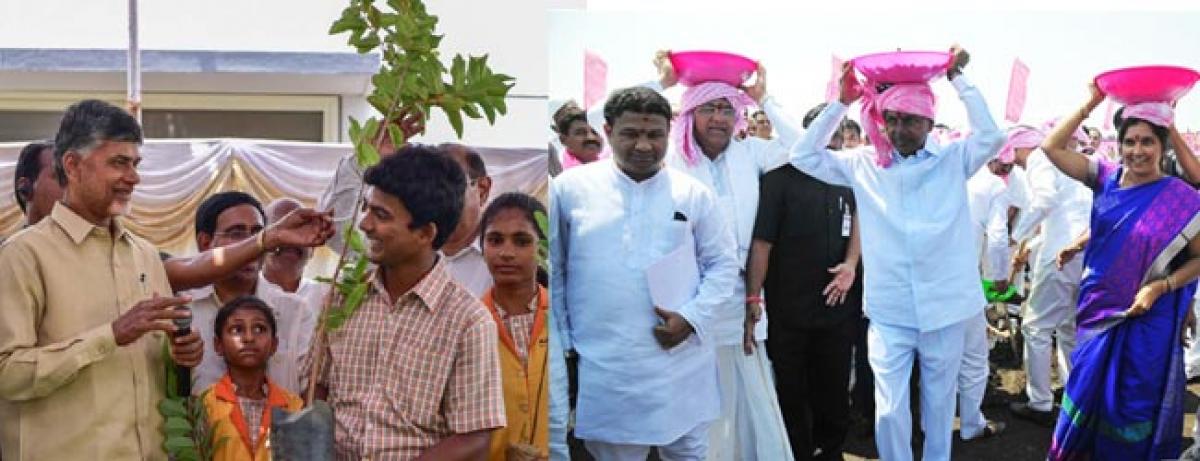Live
- Tight security arrangements at Group-II examination centers District SP
- Alia Bhatt captures attention in white
- Varun Dhawan talks about ‘Baby John’
- ‘Moonwalk’ trailer promises a quirky heist, love, and loyalty
- Combat leaf spot disease
- Ahsaas Channaopens up about her complex character in ‘Mismatched 3’
- Radhika Apte welcomes first child, shares heartfelt post
- Jacqueline dazzles at Da-Bangg Reloaded concert
- Time to boost measures to prevent drowning, save children: WHO
- TDP achieves milestone with 73 lakhs membership registration, says Chandrababu
Just In
Centre takes cue from AP, TS for drought-proofing strategy


The practices adopted by the governments of the Telugu States to counter drought have come in handy for the Centre in drafting its anti-drought strategy.
The practices adopted by the governments of the Telugu States to counter drought have come in handy for the Centre in drafting its anti-drought strategy. The advisory of the Centre to the States issued here on Wednesday seems to have borrowed extensively from the ideas and initiatives of the Governments of Andhra Pradesh and Telangana.
This was evident in the Agriculture and Farmers' Welfare Minister Dr Radha Mohan Singh's plea to the drought-affected States that they should take immediate steps to fight drought and review the same on a weekly basis, apart from suggesting the methods to be adopted.
The Minister drew the solutions extensively from the plans of the Telugu governments like construction of farm ponds, adopt micro irrigation and diversification into crops requiring less water, promotion of water storage and water conservation practices and methods like desilting of irrigation ponds, rain water harvesting and water conservation practices to rejuvenate water bodies and farm ponds etc.
It may be recalled that the Telangana Irrigation Minister T Harish Rao and AP Chief Minister N Chandrababu Naidu have been repeatedly briefing the Centre about the methods in place in their States to fight drought while seeking Central assistance to mitigate the consequences. They have suggested to the Centre to adopt these methods in their pan-Indian strategy to fight drought.
Programmes like Mission Bhagiratha and Mission Kakatiya of Telangana have come in for praise at the meetings in this regard and the details of the methods adopted to desilt ponds in Telangana submitted by the Chief Minister, K Chandrashekar Rao, during his meeting on drought here the other day had been keenly studied by the Centre, sources say.
The innovations adopted by AP, too, were explained to the Prime Minister, Narendra Modi, on Tuesday by the CM, N Chandrababu Naidu, in great detail which impressed him to such an extent that he directed the NITI Aayog to constitute a task force to study the methods for implementation of the same in the country.
Radha Mohan Singh too was candid in this regard when he admitted today that the PM gave much attention to the plans being adopted by the State Governments. Famine, water scarcity and ground water levels, both surface and underground, have prominently figured in the Centre's directive now.
This could be termed a positive takeaway from the fortnight exercise of the PM with the CMs of AP, Telangana, Chattisgarh, Jharkhand, UP, Gujarat, Maharashtra, MP, Rajasthan and Karnataka. While most of the States which interacted with the PMO, Ministry of Agriculture and other senior officials concerned in the two weeks, looked towards the Centre for guidance, the two Telugu States gave a direction to the plan to be evolved.
The PM had engaged the State governments on issues that needed immediate resolution. The problems faced currently, action taken and the proposed steps- short term on weekly basis, long term mitigation along with drought proofing measures specific to individual States had been discussed in detail.
The Agriculture Ministry advised prioritisation of water use, promotion of recycling waste water for use of the same for agriculture purpose in semi-urban areas. The Centre now wants to cover sugarcane under micro-irrigation in a phased manner in the country. Special emphasis on reviving defunct traditional/historical step wells in different parts of the country is also advised now.
The other proposals are: All water bodies to be numbered by assigning a unique identity; completion of the missing links of canals in command area by constructing underground pipelines to reduce evaporation losses besides dispensing with the requirement of land acquisition; district-wise contingency plans; information on weather, crop advisories to farmers on ‘mobile app’ in their language; use of remote sensing, satellite technology for decentralised contour and ridge mapping and for locating groundwater resources; analysis and use of Soil Health Card for mapping of regions and scientific advice for crops which best suit such regions; and encouraging the culture of seaweed, pearl and prawn culture in coastal areas.
Apart from crop diversification, the States are now to consider value addition and promotion of alternate livelihood- dairy, poultry, fishery, bee-keeping, floriculture, timber farming etc. On the issue of Pradhna Mantri Fasal Bima Yojana (PMFBY), the States are being advised to make clusters of high risk and low risk districts. While implementing PMFBY, it was also impressed upon the State governments to make use of technology to validate the crop cutting experiment and eliminate the error between area sown and area insured under different crops.
By W Chandrakanth

© 2024 Hyderabad Media House Limited/The Hans India. All rights reserved. Powered by hocalwire.com






